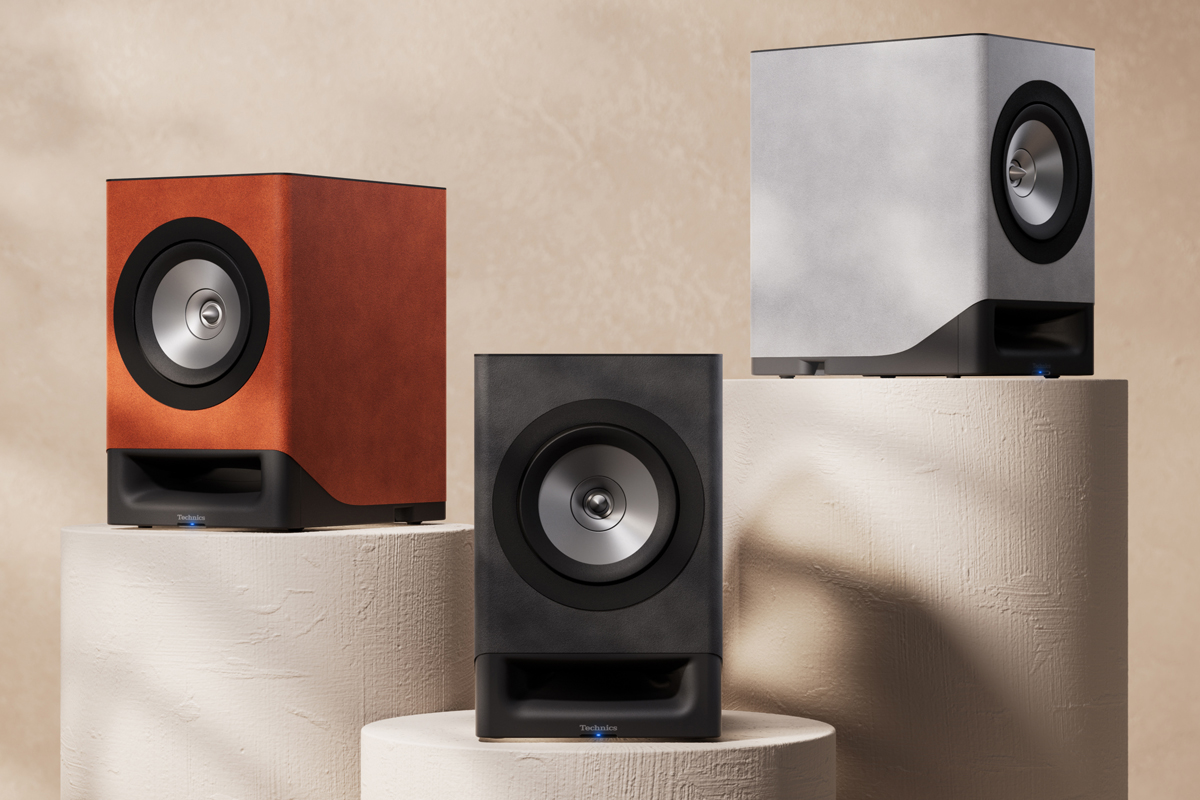As regular visitors to this website likely know, I embraced Simplifi’d hi-fi out of necessity rather than choice. In the small 1920s rowhouse my missus and I have called home since early 2018, our hi-fi system lives in the living room. There’s no other space that can serve as a listening room. For that reason, a conventional component system with passive speakers, amplifier, and source components won’t work for us, because such a system would clutter up a multipurpose space that we use for entertaining and hanging out.
I’ve had a few different setups during the six-plus years we’ve lived here, but they’ve all had one thing in common. They’ve been centered around active speakers, where the amplifiers are built into the speaker enclosures. Most of these systems also had built-in network streamers, so the only audio components in our living room were the speakers themselves.
Active speakers are widely used in professional recording studios, but their use for music playback in the home is much less common. However, a growing number of hi-fi brands are adding these versatile systems to their portfolios. In the six years I’ve been writing for Simplifi, I’ve reviewed streaming active speaker systems from Bang & Olufsen, Bowers & Wilkins, Dynaudio, JBL, KEF, Linn, PSB, and SVS. I’ve also reviewed active speaker systems that receive audio wirelessly from companion components that house network streamers, from brands such as Buchardt Audio, DALI, Mission, Q Acoustics, System Audio, and Triangle.
Now I can add another brand to that list. On September 5, 2024, Technics announced its first-ever streaming active speaker system. The SC-CX700 is a two-way bass-reflex design with a coaxial driver comprising a 5.9″ midrange-woofer and a concentrically mounted 0.75″ ring-type tweeter. The midrange-woofer is powered by a 60W amplifier and the tweeter by a 40W amp. It will be available in December for $2999.99 (all prices in USD).
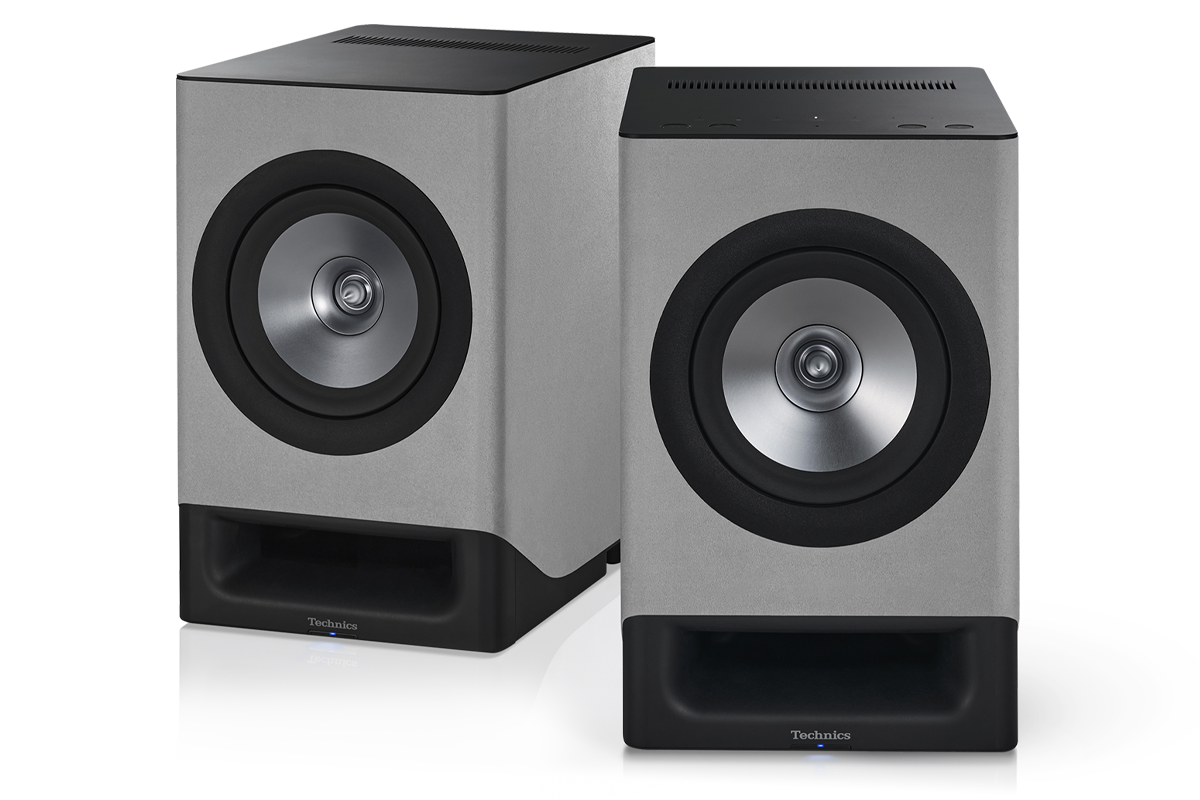
This is a very flexible system. The SC-CX700 has Bluetooth, dual-band Wi-Fi, and ethernet connectivity, and a network streamer that supports Apple AirPlay 2, Google Chromecast, Spotify Connect, and UPnP/DLNA; and it’s Roon Ready. The companion Technics Control Center app provides access to internet radio, Amazon Music, Deezer, Qobuz, and Tidal. The system can also accommodate external components such as a turntable, CD player, Mac or PC, and HDTV.
Immediately upon reading about the SC-CX700, I requested a system for review. On October 18, I picked up my review sample at Panasonic’s Canadian headquarters in Mississauga, Ontario. Technics product specialist John Healey walked me through the SC-CX700’s key features before helping load the system into my car.
Inside and out
The SC-CX700 is sold as a complete system comprising a primary speaker that houses the network streamer and connection panel for external source components, and a secondary speaker. Each speaker measures 12.3″H × 7.9″W. The primary speaker is 10.9″D and weighs 20 pounds; the secondary speaker is 10.7″D and weighs 19.6 pounds.
Using a rear-panel switch, the primary speaker can be designated for either left- or right-channel playback. It sends digital audio for the other channel to the secondary speaker wirelessly or over a supplied 3m (9.8′) ethernet cable. The two speakers are paired at the factory, so users who opt for the wireless option do not have to perform this step. Resolution is 24-bits/192kHz with a wired connection, 24/96 wireless.
The industrial design is very distinctive and, to my eyes, very attractive. The front and sides are covered in Dinamica, a suede-like microfiber. Three colors are available: Terracotta Brown, Charcoal Black, and Silky Gray, the color of my review sample. The top, bottom, and rear are dark plastic, as is the bass port on the bottom of the front baffle.
Supplied accessories include circular, magnetically attached grilles that cover the coaxial drivers and a handheld remote with power on/off, mute, volume up/down, source-selection, play/pause, and track-skip functions.
Vents at the back of the top panels of both speakers allow heat to escape from the electronics inside. In addition, the top panel on the primary speaker has push-button controls for power on/off, mute, volume-down, and volume-up, and above them, touch controls for source selection; LEDs above the touch controls show the selected source. These physical controls are a great feature, because they enable users to make quick adjustments without fumbling for the remote or firing up an app. Also on the primary speaker’s top panel is a tiny microphone that’s used for room measurements—more on that in the “Software” section below.
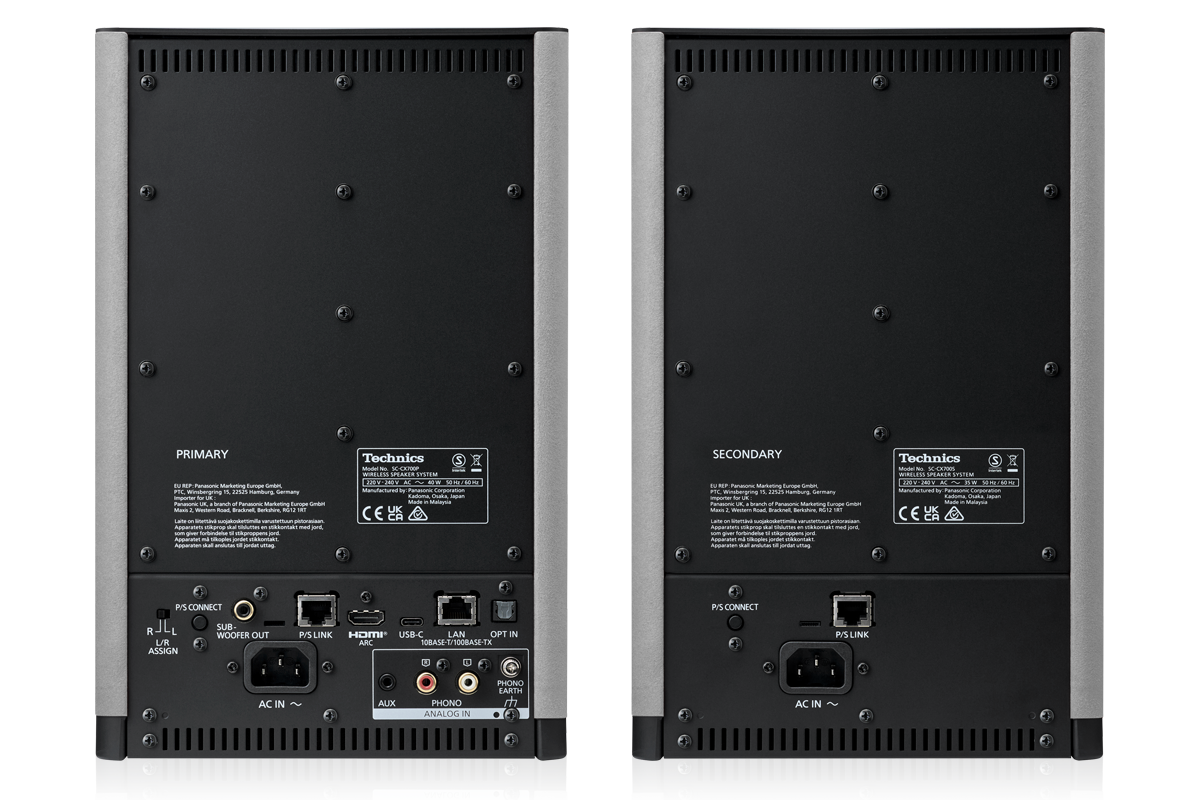
On the connection panel on the back of the primary speaker are a pair of RCA phono inputs and ground terminal for connecting a turntable, a 3.5mm auxiliary line-level input, an HDMI ARC input for receiving audio from an HDTV, a USB type-C port for connecting a PC or Mac, an optical S/PDIF (TosLink) input for connecting a digital component such as a disc player, an ethernet port labeled “LAN” for hardwiring the system to a network router or access point, a second ethernet port marked “P/S” (primary/secondary) for linking the two speakers, a small button marked “P/S Connect” for pairing the two speakers wirelessly if the system is reset and the speakers become unpaired, a two-position switch for selecting which stereo channel the primary speaker should play, and a three-prong IEC power inlet.
There’s also an RCA subwoofer output jack. The sub output is not low-pass filtered—it outputs a full-bandwidth, summed-mono signal. And the SC-CX700 does not implement a high-pass filter for the main speakers when a sub is connected. Especially in larger rooms, the SC-CX700 will benefit from the addition of a subwoofer, so it’s too bad that it lacks bass management. Other active speaker systems from brands like Dynaudio, JBL, KEF, Klipsch, PSB, and SVS will implement a high-pass filter for the main speakers when a sub is connected, which frees the speakers from having to reproduce deep bass.
The back panel of the secondary speaker is simpler: there’s just the P/S port, P/S Connect button, and three-prong power inlet.
Supported file formats include MP3, AAC, WAV, FLAC, AIFF, ALAC, and DSD DFF and DSF. Via the USB-C input, the SC-CX700 can accept PCM audio up to 24/192 and DSD up to 11.2MHz (DSD256). Via ethernet and Wi-Fi, it can accept PCM audio to 24/384 and DSD to 11.2MHz. Signals received from the phono and auxiliary inputs are converted to 24/48 PCM before being passed on to the digital processor in the primary speaker.
In addition to implementing the active crossover, which is centered on 2.5kHz, the DSP enables a feature called Model Based Diaphragm Control (MBDC), which compensates for known non-linearities in the SC-CX700’s midrange-woofer. This reduces harmonic distortion and improves bass definition and soundstaging, Technics says. The DSP also enables a feature called Space Tune that compensates for speaker placement and room acoustics—more about that in the next section.
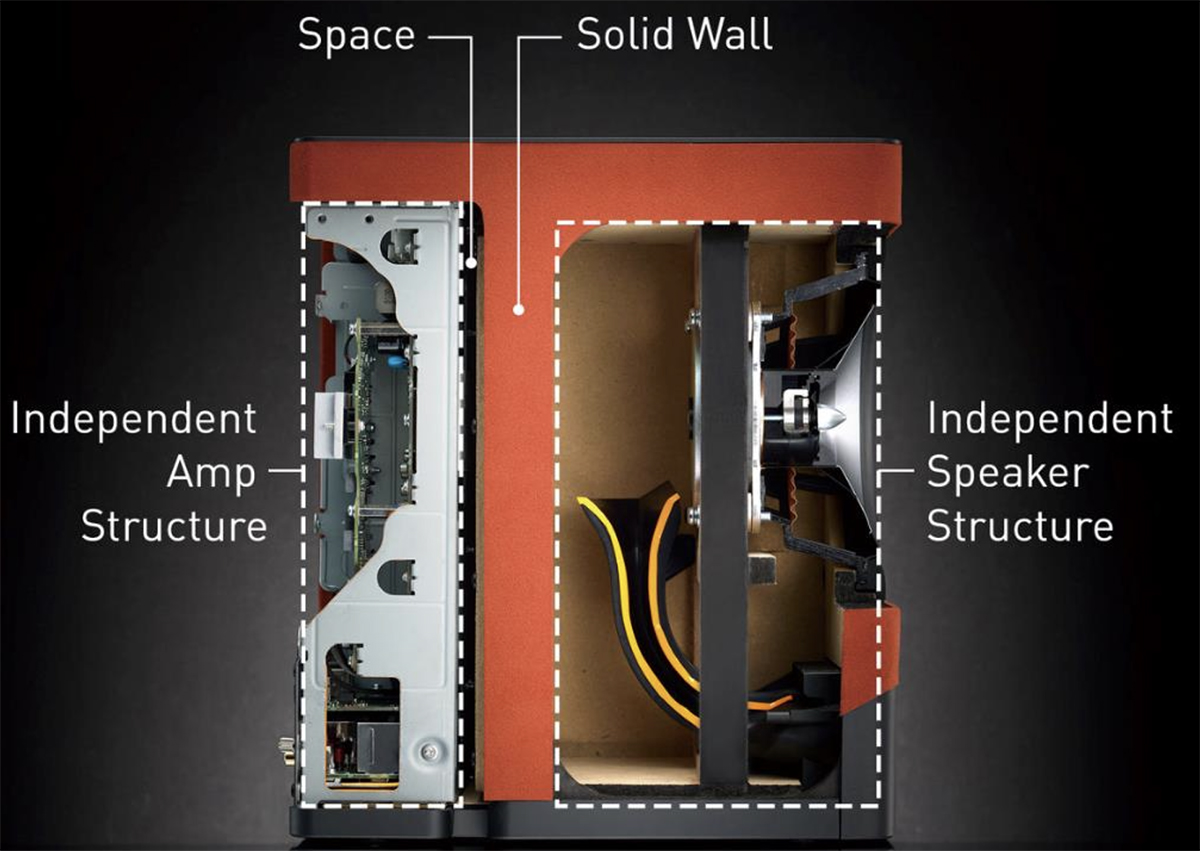
In both the primary and secondary speakers, the electronics are in an isolated sub-enclosure. This prevents vibrations from the drivers from affecting the amplifiers, Healey explained during my visit to Panasonic Canada. Instead of being suspended from the basket attached to the front baffle, the coaxial driver is suspended from the midrange-woofer driver’s magnet on an internal structure that coincides with the driver’s center of gravity.
Technics doesn’t publish a frequency-response spec for the SC-CX700, so I asked Healey about that. He queried headquarters in Japan, and a couple of days later, passed on their reply. Frequency response is 41Hz–47kHz, ±10dB. From that, I infer that response is down 10dB at 41Hz relative to 1kHz.
Software
As noted, I received my review sample several weeks before the SC-CX700 was due to go on sale. But Healey told me that the firmware in the sample was the final release version. Per the Quick Start Guide, I downloaded the iOS version to my iPhone 14 and the Android version to my Google Pixel 4a 5G smartphone. I ran into some issues with the iOS version, which I reported to Healey. He set me up with a pre-release version of an update to Technics Control Center, and that worked fine.
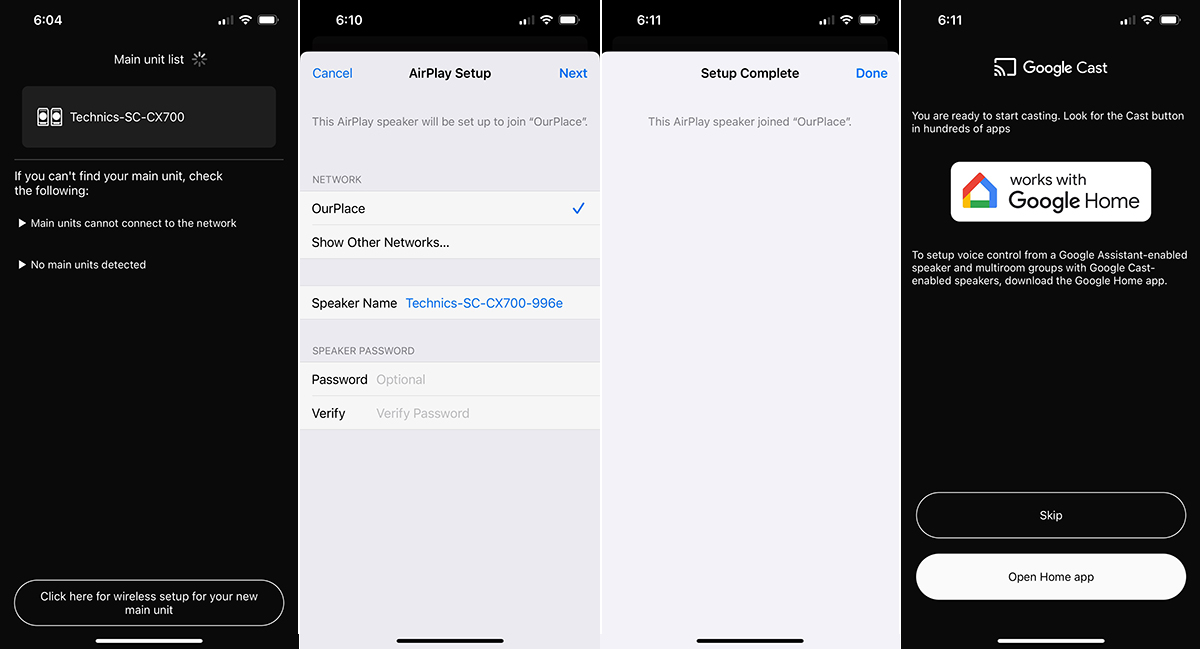
On my iPhone, the app asked if I wanted to connect the Technics system to my Wi-Fi network and then bumped me to the AirPlay Accessory Setup menu in the iOS Settings app, where I confirmed the name of my network. The iOS Settings app connected the system to my home network, which it confirmed by playing a beep through the speakers. Then the Technics app offered to send me to the Google Home app so that I could set the SC-CX700 up as a Chromecast device. All good.
I reset the system and repeated the setup process with the Android version of Technics Control Center. The app asked me to select a network from a drop-down list and then enter my network password, after which I was connected. Again, I was directed to the Google Home app to set the system up as a Chromecast device. Easy-peasy.
I found the Technics Control Center app stable, easy to navigate, and function-rich. You can use it to select sources, play music from supported streaming services, play music stored on your device, play podcasts and internet radio, and adjust volume. There is a favorites menu for storing up to nine playlists, podcasts, or internet radio stations.
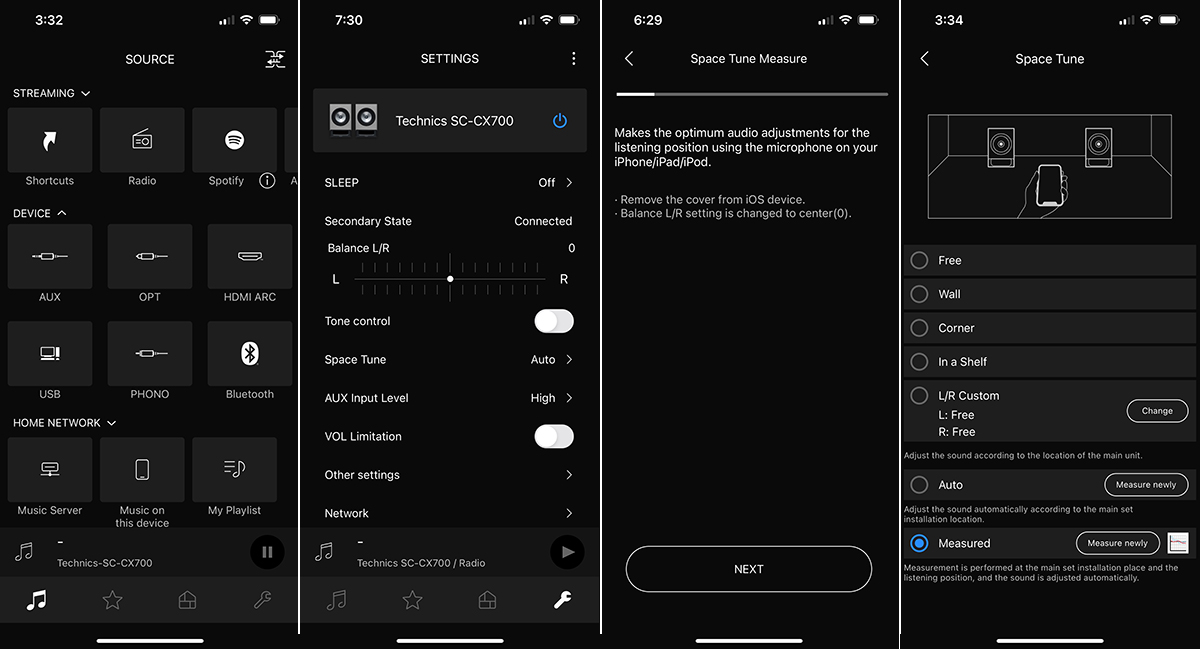
One very useful function is Space Tune, which is found in the Settings menu. You can specify whether the system is placed in the open, next to a wall, in a corner, or on a shelf, and the SC-CX700 will adjust output accordingly. Different settings can be selected for the left and right speakers.
There’s also an Auto option that measures room acoustics using the microphone built into the primary speaker and a Measured option that measures sound at the listening location using the microphone on an iOS device. In both cases, test tones are played through the primary and secondary speakers, after which the app creates filters to compensate for room acoustics.
Setup
For my listening tests, I placed the SC-CX700 speakers on 27.5″-high, sand-filled speaker stands on either side of the electric fireplace in our living room. The speakers were 7′ apart, tweeter center to tweeter center, and 7′ from my listening position on the end cushion of our sectional sofa against the opposite wall, with the tweeters almost exactly at ear level. The speakers’ rear panels were 14″ from the front wall.
I did not use the tethering cable to link the primary and secondary speakers. Throughout my listening I had them paired wirelessly, and except for one brief blip, experienced nary a hiccup.
With the SC-CX700 connected to my Wi-Fi network, I did some casual listening with Space Tune set to Free, the default setting. Right from the get-go, I was really taken with the sound of this attractive system. The two speakers threw a broad, deep soundstage, with very precise aural images. For such small speakers, dynamics were outstanding. This system had a lively character which made it exciting to listen to, but also added a slightly hard edge to some music.
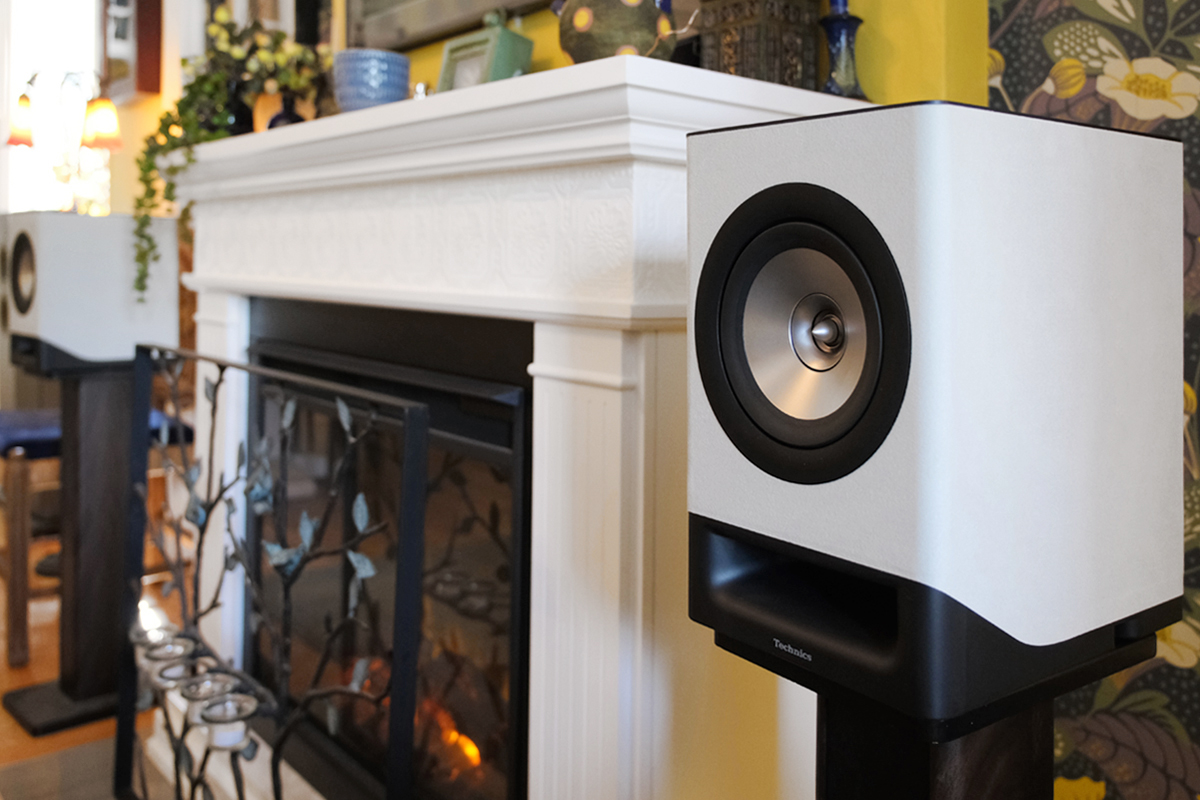
After getting acclimatized, I tried out Space Tune’s Auto and Measured options. On the Auto setting, the presentation was a little more transparent; the sound on the Free setting was a bit congested by comparison. The improvement was still greater with the Measured option enabled. The soundstage was even wider and deeper, and the placement of aural images a little more precise. I did almost all of my listening with the Measured option in Space Tune engaged.
During the review period, I streamed music to the SC-CX700 from my iPhone 14 via AirPlay, from the Qobuz app on my Google Pixel 4a 5G smartphone via Google Cast, and from the Audirvāna app on my HP x360 Spectre laptop PC via UPnP, all without issue. I also streamed music stored on my Google Pixel phone to the SC-CX700 using the Technics Control Center app, and connected my MacBook Pro to the SC-CX700’s USB port and played music stored on my computer, again without issue. But most of my listening was done from Roon, streaming music from the Roon Labs Nucleus One server in my second-floor home office.
Listening
As the SC-CX700 is the first-ever streaming active speaker system from this beloved Japanese brand, I thought it appropriate to start my serious listening with an acclaimed Japanese audiophile jazz recording: the Tsuyoshi Yamamoto Trio’s 1974 album Misty (DSD64, rip from First Impression Music FIM SACD 062).
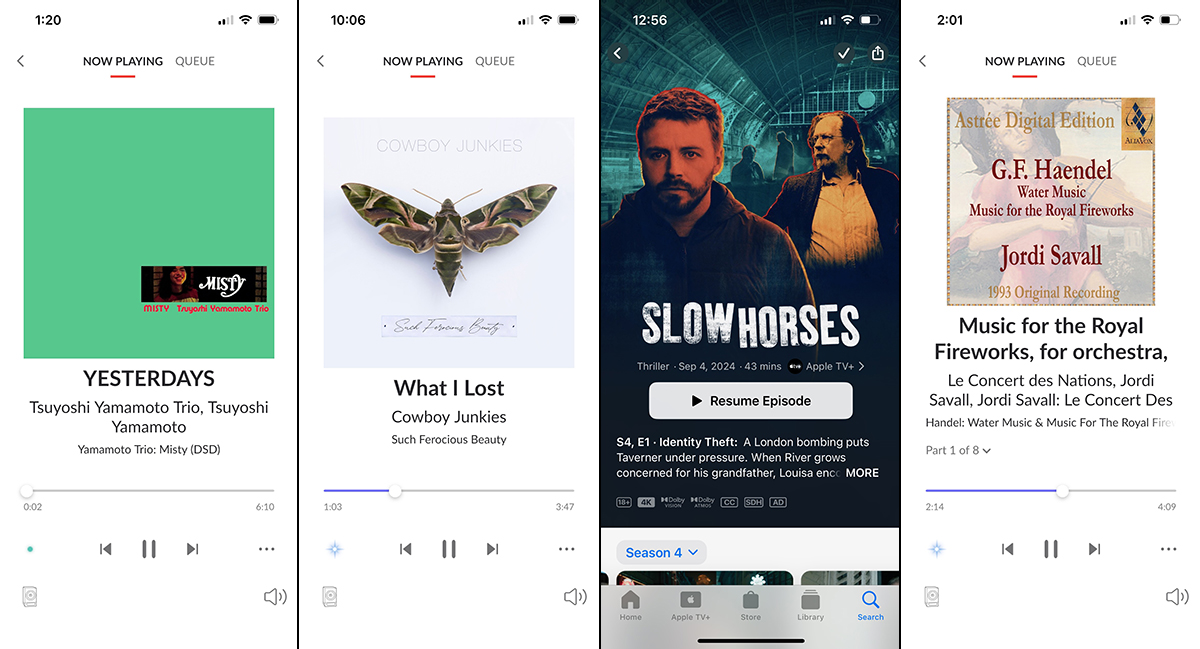
After learning about the SC-CX700’s frequency response, I expected bass output to be a bit anemic, but I was pleasantly surprised by the way it rendered double bassist Isoo Fukui’s long solo at the beginning of Jerome Kern’s “Yesterdays.” Middle and upper notes sounded delectable. Fukui’s plucks were well defined, as were the vibrations of the strings against the neck, but these sounds weren’t at all exaggerated. And the ensuing decay of the instrument’s soundbox was delicious. The Technics speakers lost a bit of gas in the lowest notes—Fukui’s big plucks on the open E string (41Hz) didn’t sound as full as I’ve heard on larger systems, but they certainly weren’t missing in action. Considering the size of these speakers, I found their performance on this solo very impressive.
The performance was just as satisfying higher in the audioband. Pianist Tsuyoshi Yamamoto has an intense, hard-hitting style, and the Technics system nailed it. His sharp staccato phrases exploded effortlessly out of the middle and right side of the soundstage, but this system also made it easy to appreciate his subtle touch on the legato passages early in the track. Timbre was consistent throughout the piano’s range.
On the right side of the soundstage, every piece of Tetsujiro Obara’s drum kit had a clearly defined location. During the louder portions of the track, his strikes on the snare drum and woodblock were fast and impactful, and in the quieter passages, the gentle swishes and taps of his brushes on the snare and cymbal were beautifully resolved. This is an amazing recording, and the Technics system did it complete justice. I felt like I was in a bar seated about 10 feet from the trio. I wanted to order a cocktail.
On some recordings, I heard a bit too much upper-midrange and lower-treble energy. Voices sometimes had a papery edge, and violins sometimes sounded too steely. With close-miked female voices, sibilants were often too hot. But on well-balanced recordings, this was less of an issue. For example, I was aware of slightly hot sibilants in Margo Timmins’s singing on “What I Lost,” the opening track of the Cowboy Junkies’ 2023 album Such Ferocious Beauty (24-bit/44.1kHz FLAC, Latent Recordings / Qobuz). And in passages where she sings loudly, her voice became a little edgy. But what stood out more was the way the Technics system conveyed her expressive changes in tone and dynamics, highlighting the grief and vulnerability that pervade this song about an aging parent.
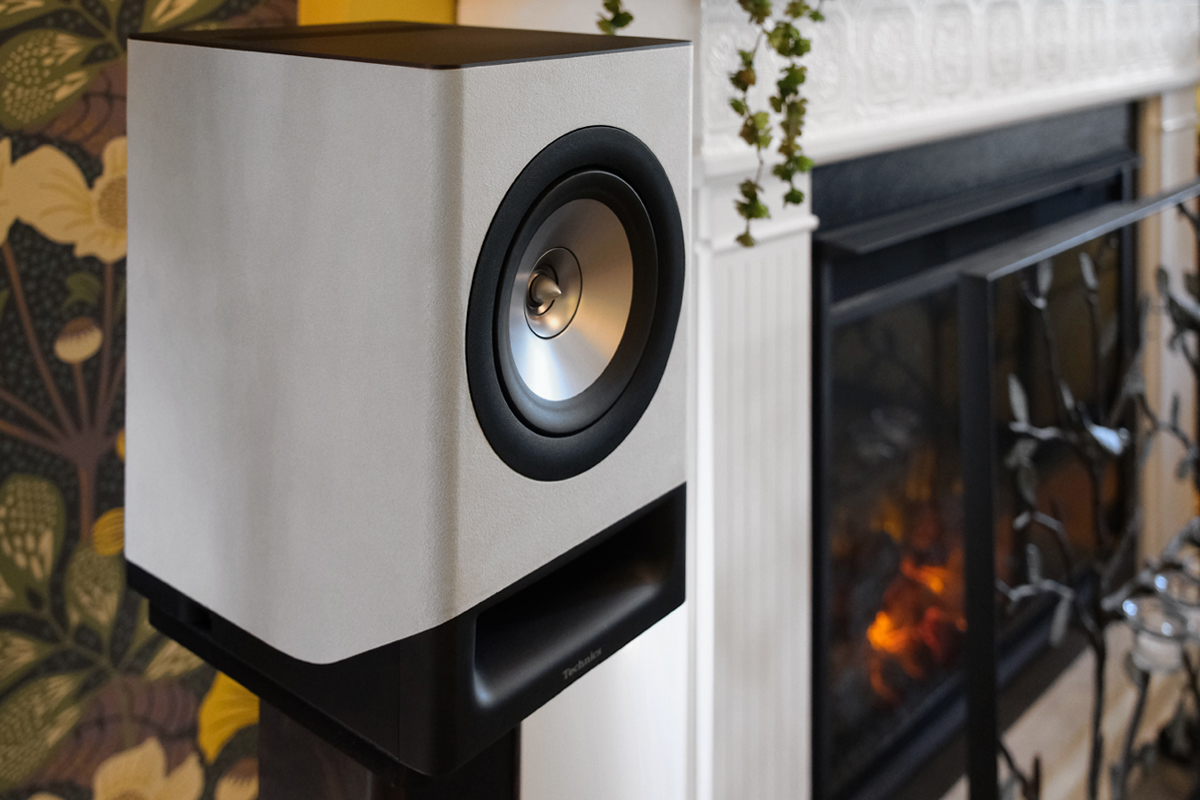
This great recording revealed other strengths of the little Technics system. The soundstage was huge, extending several feet outside the boundaries of the two speakers and far behind the front wall of my listening room. Aural images were drawn with holographic precision. Margo Timmins’s voice appeared above and slightly behind the speaker plane—it seemed as if I could reach out and touch her. Just in front of her and to her left (my right) at the beginning of the song was Michael Timmins’s acoustic guitar, the steel strings ringing beautifully and segueing convincingly into the resonance of the soundbox. Later in the song, his electric guitar screamed mournfully on the left side of the soundstage, right in front.
While Alan Anton’s pounding bass-guitar notes were fainter than I’d heard on other systems, they had fantastic definition and excellent pitch differentiation. Peter Timmins’s drum kit was arrayed across the rear of the soundstage, extending far outside the boundaries of the two speakers. It seemed like I was surrounded by percussive surfaces, yet every piece of the kit—kick drum, snare, cymbals, hi-hat—had a precise location. However, his hi-hat rolls had slightly excessive sizzle. The kick drum had impressive oomph, coming from such small speakers.
To assess the SC-CX700’s phono stage, I hooked up my tricked-out Pro-Ject Debut Carbon Evo turntable (see Associated Equipment endnote for details) and spun a recent find from a local record store: Jazz Samba by Stan Getz and Charlie Byrd (Verve MIJ 1 5329). Even before dropping the needle, I was impressed. With my ears 6″ from one of the speakers, I heard no hum or hiss—none at all. When I lowered the tonearm, the only noise I heard was the surface noise of this gently used LP—followed by the music, which sounded glorious.
I loved the way this system conveyed the varied dynamics of Getz’s work on the tenor saxophone. His big toots emerged effortlessly from the far right of the soundstage, but the Technics system also showed off all the subtleties in Getz’s phrasing and blowing. The timbre of his instrument was completely convincing. Over on the left, I admired the delivery of Byrd’s nylon-strung acoustic guitar. His picking and strumming were clearly defined without being exaggerated. The double bass in the middle right, which is not very prominent in this recording, sounded a little faint through the Technics system.

To assess how the SC-CX700 works for movies and TV, I connected the HDMI ARC input to the breakout box for my 55″ Samsung Frame TV and cued up Season 4, Episode 1 of the superb spy series Slow Horses on Apple TV. The sounds of shouting and sirens on a street following an explosion in a shopping center spread through the front half of my room, creating a sense of danger and chaos. Dialog was always clear and intelligible, but both male and female voices had a slightly papery edge, with sibilants that were a bit too pronounced. In a later scene, rolling thunder in an outdoor setting wasn’t particularly deep or threatening, but had excellent detail and texture—pretty impressive for a system of this size. Foley effects like glasses tinkling in a bar, rain falling in a farmer’s field, and running bathwater were very convincing, adding to the realism of the scenes where they appeared.
A musical highlight was Mick Jagger singing the theme music for the series. This system captured his snarling contempt beautifully. I’d have liked the bass guitar to pound more heavily, but the bluesy electric guitar and electronic effects were immensely satisfying.
Comparison
I compared the SC-CX700 system with Triangle’s Capella active speaker system, which I reviewed on August 1. The Capella is a two-way ported system with a 6.3″ cellulose-pulp midrange-woofer crossed over at 3.6kHz to a 1″ horn-loaded magnesium-dome tweeter. Each driver is powered by a 50W class-D amp. The Capella retails for $2999, including the companion Stereo Hub, which uses WiSA (Wireless Speaker and Audio) technology to send 24/96 digital audio to the two speakers.
I chose a spectacular orchestral recording for this comparison—Handel’s Music for the Royal Fireworks, with early-music specialist Jordi Savall conducting Le Concert des Nations (DSD64, rip from Alia Vox ASVA 9860). I started with the Space Tune feature on the Technics system at its default Free setting, and the Triangle’s Room EQ system disabled.
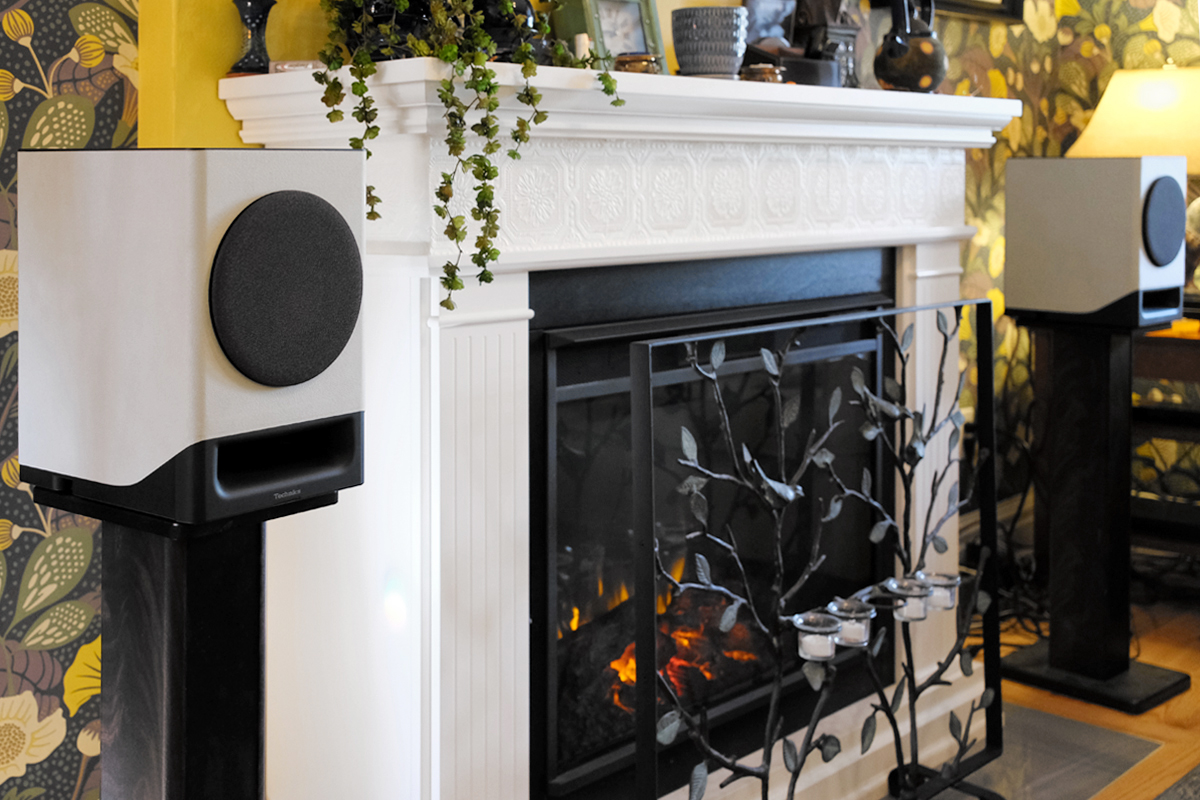
The big timpani thwacks at the beginning of the first movement, Overture, had sharper attacks through the Technics system, but sounded fuller, with more palpability, through the Triangle speakers. The period brass instruments sounded glorious through both systems, but the trumpets had a bit more bite through the Technics speakers. Through the Technics system, the strings had more texture, but the antique violins sounded a little edgier than they did through the Triangles. The Technics system threw a broader, deeper soundstage, and the location of instruments was more precise. The presentation through the Triangle system was a bit opaque by comparison.
Next, I repeated the comparison, but this time selected the Measured option in Space Tune, as I had done for most of my listening, and enabled the Room EQ feature on the Triangle system.
As before, the SC-CX700’s presentation was more transparent with the Measured option, but the sound was not quite as full through the midrange. On the Triangle system, the sound was fuller with Room EQ enabled. This magnified the differences I heard earlier. The Technics system was more transparent. The soundstage was deeper, and instruments were placed more precisely. But the Triangle system sounded bigger and more powerful, more convincingly evoking the experience of a live concert. The Technics system sounded a little brasher, but clearer; the Triangle system was smoother, but more opaque.
Conclusion
The SC-CX700 is an impressive entry into the market for streaming active speaker systems. It has a distinct, attractive design; extensive connectivity options; a streamer that supports all the major protocols; and a well-designed app that works reliably. The feature set is attractive. While I’d like to see Technics add bass-management capability to this system, I appreciated the physical controls on the primary speaker and the fact that the primary speaker can be used to play either channel. Those two last features are less common than they should be.
I’ve picked a couple of nits about the sound, but these should be kept in perspective. The elevated upper midrange and lower treble that I heard on some recordings never made me wince—not even close. Bass response wasn’t as deep as I’d have liked, but bass definition was consistently excellent.
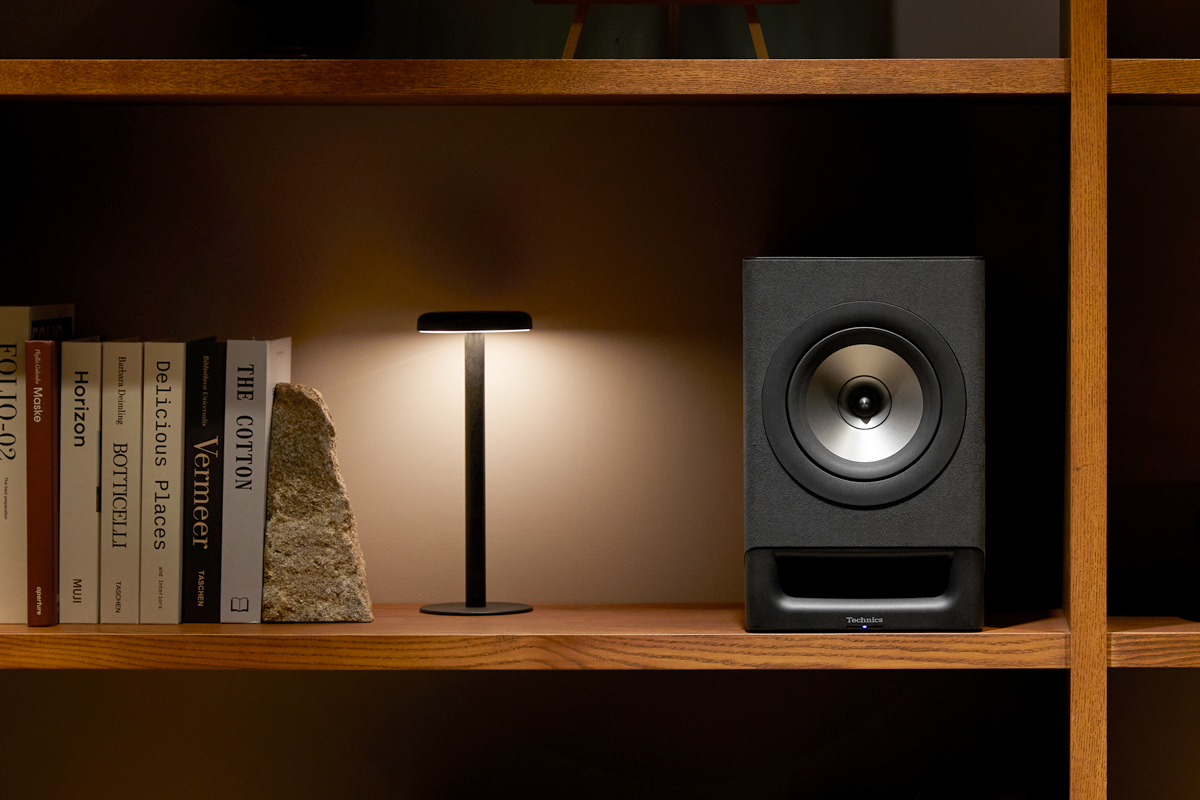
On the other hand, soundstaging and imaging were outstanding. Sonically, these speakers completely disappeared—the only evidence of their presence was visual, and I really liked the way they looked. They created what may be the most immersive soundstage and the most precise imaging I’ve ever experienced in my living room. They could deliver satisfyingly high levels without sounding distressed or compressed.
While the range of streaming active speakers is much more limited than conventional passive speakers, there are many excellent options. With the new Technics SC-CX700, the range of choices is now a little greater. If you’re looking for an affordable, low-footprint system that can deliver audiophile-grade sound in a multipurpose living space, make sure the SC-CX700 is on your shortlist.
. . . Gordon Brockhouse
Associated Equipment
- Music server: Roon Labs Nucleus One
- Sources and control devices: Apple iPhone 14, Google Pixel 4a 5G, Apple MacBook Pro (M3, 2023), HP Spectre x360 notebook PC
- Turntable: Pro-Ject Debut Carbon Evo with Ortofon 2M Blue cartridge, Debut Alu subplatter, Acryl it platter
- Active speaker system: Triangle Capella and Stereo Hub
- Speaker stands: BQKOZFIN (27.5″)
- Display: Samsung UN55LS003 UHD TV “The Frame”
- Network: Google Wifi four-node mesh network
Technics SC-CX700 streaming active loudspeaker system
Price: $2999.99
Warranty: Three years, parts and labor
Panasonic Corporation of North America
Two Riverfront Plaza
Newark, NJ 07102-5490
Phone: (201) 348-7000
Website: www.technics.com





